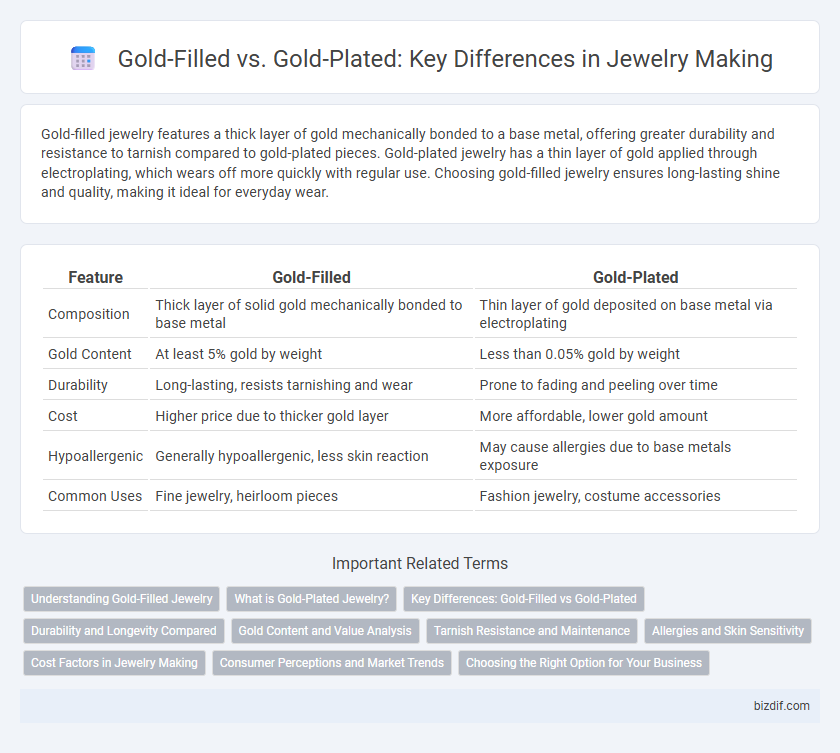Gold-filled jewelry features a thick layer of gold mechanically bonded to a base metal, offering greater durability and resistance to tarnish compared to gold-plated pieces. Gold-plated jewelry has a thin layer of gold applied through electroplating, which wears off more quickly with regular use. Choosing gold-filled jewelry ensures long-lasting shine and quality, making it ideal for everyday wear.
Table of Comparison
| Feature | Gold-Filled | Gold-Plated |
|---|---|---|
| Composition | Thick layer of solid gold mechanically bonded to base metal | Thin layer of gold deposited on base metal via electroplating |
| Gold Content | At least 5% gold by weight | Less than 0.05% gold by weight |
| Durability | Long-lasting, resists tarnishing and wear | Prone to fading and peeling over time |
| Cost | Higher price due to thicker gold layer | More affordable, lower gold amount |
| Hypoallergenic | Generally hypoallergenic, less skin reaction | May cause allergies due to base metals exposure |
| Common Uses | Fine jewelry, heirloom pieces | Fashion jewelry, costume accessories |
Understanding Gold-Filled Jewelry
Gold-filled jewelry consists of a thick layer of gold mechanically bonded to a base metal, typically brass, providing durability and resistance to tarnish compared to gold-plated pieces which have a thin gold layer applied through electroplating. The gold content in gold-filled jewelry must be at least 5% of the item's total weight, making it significantly more valuable and long-lasting than gold-plated alternatives. This high gold content ensures that gold-filled jewelry maintains its appearance for years, offering a cost-effective option for fine, everyday wear without the risk of rapid fading or peeling.
What is Gold-Plated Jewelry?
Gold-plated jewelry consists of a base metal coated with a thin layer of gold through electrochemical plating, offering an affordable alternative to solid gold pieces. The gold layer typically measures less than 0.05 microns, making it prone to wear and tarnish over time. This type of jewelry provides the appearance of gold at a fraction of the cost but requires careful maintenance to preserve its finish.
Key Differences: Gold-Filled vs Gold-Plated
Gold-filled jewelry contains a thick layer of gold mechanically bonded to a base metal, typically lasting many years without tarnishing, while gold-plated jewelry has a thin gold layer applied through electroplating that wears off relatively quickly. Gold-filled pieces generally have a higher gold content, often about 5% of the item's total weight, making them more durable and hypoallergenic compared to gold-plated items, which have a minimal gold layer. The cost difference is significant; gold-filled is more expensive but offers better longevity, whereas gold-plated jewelry is more affordable for temporary or fashion use.
Durability and Longevity Compared
Gold-filled jewelry offers superior durability and longevity compared to gold-plated pieces due to its thick layer of gold mechanically bonded to a base metal, typically lasting decades without significant wear. Gold-plated jewelry has a much thinner layer of gold applied through electroplating, which tends to wear off within months to a few years, exposing the base metal underneath. For long-lasting investments, gold-filled items maintain their appearance and value far better under daily wear conditions.
Gold Content and Value Analysis
Gold-filled jewelry contains a thick layer of gold mechanically bonded to a base metal, with gold content typically ranging from 5% to 10%, offering higher durability and lasting value compared to gold-plated pieces. Gold-plated jewelry has a much thinner gold layer, often less than 0.1%, which wears off more quickly and holds significantly lower intrinsic value. The substantial gold content in gold-filled items ensures better resistance to tarnish and retains a closer resemblance to solid gold, making it a more valuable choice for long-term wear.
Tarnish Resistance and Maintenance
Gold-filled jewelry offers superior tarnish resistance because it contains a thick layer of gold bonded to a base metal, significantly reducing exposure to tarnishing agents compared to gold-plated pieces. Gold-plated items have a much thinner gold layer that can wear off quickly, requiring more frequent cleaning and careful maintenance to prevent discoloration. Proper care like storing jewelry in airtight containers and avoiding exposure to chemicals enhances longevity for both gold-filled and gold-plated jewelry.
Allergies and Skin Sensitivity
Gold-filled jewelry contains a thick layer of gold bonded to a base metal, reducing the risk of allergic reactions and making it ideal for sensitive skin. Gold-plated items have a much thinner gold coating, which can wear off quickly, exposing the base metal and increasing the likelihood of skin irritation. Choosing gold-filled pieces provides longer-lasting hypoallergenic benefits compared to gold-plated alternatives.
Cost Factors in Jewelry Making
Gold-filled jewelry contains a thick layer of gold mechanically bonded to a base metal, offering greater durability and higher intrinsic gold content, which increases production costs compared to gold-plated items. Gold-plated jewelry involves a thin layer of gold electroplated onto a base metal, resulting in significantly lower material expenses but reduced longevity. The choice between gold-filled and gold-plated directly impacts manufacturing costs, retail pricing, and perceived value in the jewelry market.
Consumer Perceptions and Market Trends
Gold-filled jewelry is perceived as higher quality and more durable compared to gold-plated options, driving consumer preference towards long-lasting pieces with better value. Market trends indicate a growing demand for gold-filled items due to increased awareness of metal allergies and the desire for hypoallergenic materials. Retailers are capitalizing on this shift by promoting gold-filled jewelry as a premium alternative to gold-plated accessories, influencing purchasing behavior and pricing strategies.
Choosing the Right Option for Your Business
Gold-filled jewelry contains a thick layer of gold bonded to a base metal, offering greater durability and resistance to tarnish compared to gold-plated pieces, which have a thin gold layer that wears off over time. For businesses targeting customers seeking long-lasting, high-quality products, investing in gold-filled materials enhances brand reputation and reduces returns. Conversely, gold-plated items provide an affordable option suitable for fashion-forward, fast-selling collections, appealing to budget-conscious clients who prefer trendy, affordable accessories.
Gold-Filled vs Gold-Plated Infographic

 bizdif.com
bizdif.com